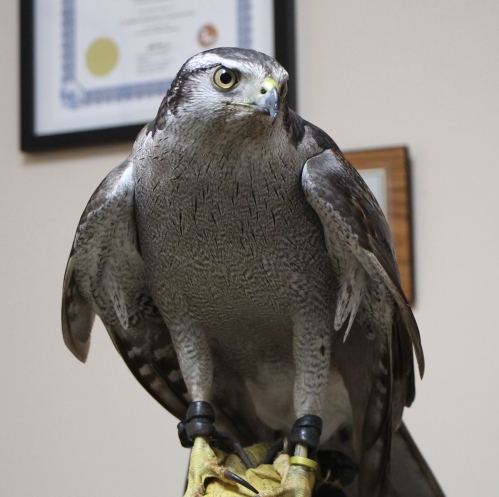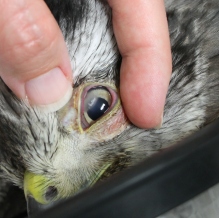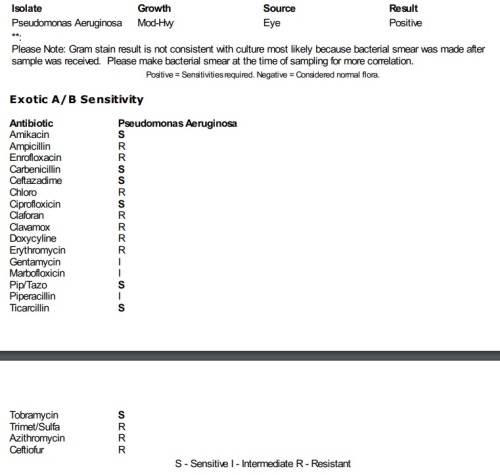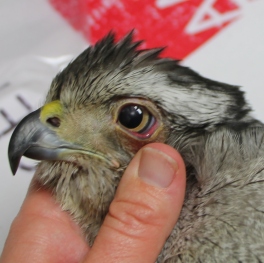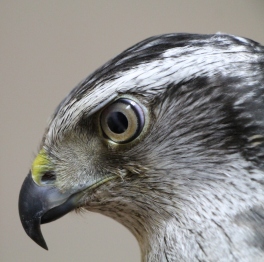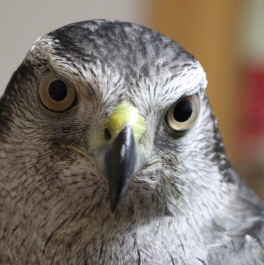The Northern goshawk (Accipiter gentilis) is found throughout North America and Eurasia. One of my clients is a falconer and owns this bird legally. This case is reported with the owner’s permission in the hopes that it could help other veterinarians or falconers faced with a similar situation.
At the time of presentation, the bird was 22 months old and weighed about 780 gm. The owner noticed a cloudy appearance in the bird’s left eye. It’s not unusual for this bird to dive into dense vegetation in the pursuit of rabbits and it’s thought that he may have scratched his eye.
Initial diagnostics included corneal cytology and a swab of the cornea for culture and sensitivity. When preliminary results became available five days later, the corneal lesion had progressed significantly. Thankfully, fungal infection was ruled out.
The culture grew Pseudomonas aeruginosa, a particularly nasty type of bacterial infection. It was sensitive to tobramycin, which I had at our hospital, so I prescribed some for topical use while I reached out to additional raptor specialists for advice.
After hearing back from a veterinary ophthalmologist who works with wildlife, I changed the course of treatment. We stopped tobramycin and switched to topical moxifloxacin (available through regular human pharmacies) and oral doxycycline (25 mg orally every 12 hours for 14 days). The moxifloxacin needed to be applied to the eye six times per day for the first five days, then five times per day until resolved.
How does one apply eye drops to a wild bird?
I obtained the following guidance, which I hope will be of use to others:
Eye medication
-
- Approach and retreat techniques (negative reinforcement in the realm of operant conditioning) were used to begin the training process for applying eye medications unrestrained in the bird’s enclosure.
- The bird is slowly approached with the eye medication bottle until visible signs of stress are observed = the bird’s fear threshold
- Signs of stress include wings out, fanned tail, and increased respiratory rate.
- Wait in the same location where the signs of stress were observed until you see one small sign of improvement
- Tucking of the wings or tail will come first, a calm respiratory rate will be the last sign of stress to resolve
- When the bird relaxes, slowly move your hand back a few inches and wait there for ~30 seconds as the release or reward – by moving away from the bird, which is what the bird ultimately wants, we are teaching the bird that if they stand calmly on their perch with their wings tucked we will go away.
- Retreat slowly – this bird tends to get nervous when you move away, especially quickly. In some cases, we have used maintaining the same distance for 30 seconds – 1 minute as a reward
- Then gradually approach again until signs of stress/the fear threshold is reached and pause as above
- Approaching slowly in a stepwise fashion, allowing the bird to relax after each step, has worked well for this individual to facilitate administration of eye medications within 3 mins or less twice daily
Not sure if these links will work, but you can try them:
- https://drive.google.com/file/d/1M7YSmtVb0v5LX7v_7jlpkMnfr3TxkaUp/view
- https://drive.google.com/file/d/1DVO0G31J4WA8DU9U_1371qoD13ABvaP8/view
- https://drive.google.com/file/d/0Bzoo8FqXt1bAczd4NFBENVFJSEE/view
Thankfully, the client was able to get the moxifloxacin drops into the left eye as directed, and after seven days of treatment, improvement was evident.
Approximately 16 days after beginning treatment, the owner noted that his eyelid was looking a little irritated and he was keeping the eye closed, only opening it in low light or when extremely curious. We decided to discontinue topical treatment until I could perform a medical progress exam.
At the recheck exam–one month after initiating treatment and two weeks since discontinuing treatment–the cornea was completely clear except for one thread of neovascularization extending from 12 o’clock to the center of the cornea. He was consistently holding his eye open and looked comfortable. I expect his vision to remain excellent, although it will likely take another month or more for the neovascularization to retreat and a small scar is possible.
A repeat culture and sensitivity was negative for Pseudomonas!

